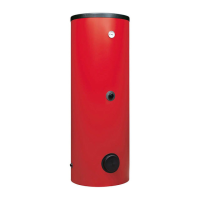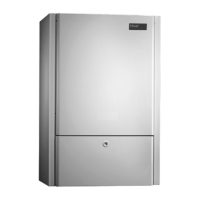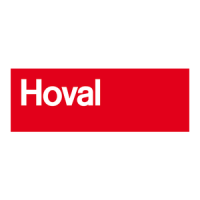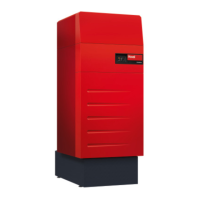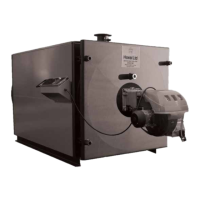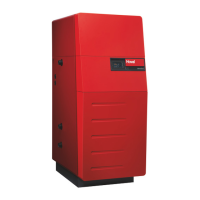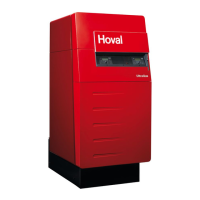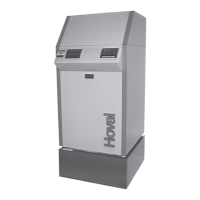
Do you have a question about the Hoval Max-3 plus Series and is the answer not in the manual?
General introduction to the Hoval Max-3 plus boiler range.
Essential safety conditions required for boiler operation and trial runs.
Compliance with British Standards, IEE Regulations, and local by-laws.
Instructions for installing the boiler, including plinth and levelling.
Guidance on mounting the boiler onto a plinth and ensuring correct levelling.
Procedure for changing the boiler door opening direction to the left side.
Step-by-step guide for applying thermal insulation mats to the boiler body.
Instructions for fitting the boiler cladding and control box.
Applying thermal insulation mats to the boiler body for models 1000-1250.
Installing the boiler cladding and control box for models 1000-1250.
Applying thermal insulation mats to the boiler body for models 1500-2700.
Installing the boiler cladding and control box for models 1500-2700.
Details on the boiler's three-pass design and flue gas path.
Statement of compliance with relevant EU directives and standards.
Specification table for Max-3 plus boilers, including output, efficiency, and dimensions.
Dimensional drawings and table for Max-3 plus models 420-1250.
Dimensional drawings and table for Max-3 plus models 1500-2700.
Boiler dimensions without thermal insulation and casing for all models.
Requirements for adequate air supply for combustion and cooling in the boiler room.
Requirements for pressurised heating system configurations.
Guidance on flue and chimney sizing, installation, and regulations.
Guidelines for using fan dilution systems for flue gas evacuation.
Procedures for mounting the burner to the boiler flange.
Chart showing combustion chamber resistance versus boiler output.
Information on approved fuels for the Max-3 plus boilers.
Guidelines for electrical connections, including burner wiring.
Chart showing flue gas temperature relative to boiler output.
Measures to ensure minimum boiler feed and return temperatures.
Requirements for installing a safety valve for overpressure protection.
Information and installation of gas boosters.
Standards for heating water quality, including EN 14868 and VDI 2035.
Procedure for filling the heating system by a skilled tradesman.
Essential checks to be completed by the heating engineer before commissioning.
Recording of all boiler and burner settings on a formal report.
Explaining operating instructions and safe-keeping of the system.
Using the control unit for emissions metering and manual operation modes.
Minimum instructions for operators to start, run, and stop the boiler.
Steps for starting up the boiler after cleaning or summer shutdown.
General requirements for qualified service engineers.
Regular checks to be performed between main servicing periods.
Recommended checks for all boiler and burner components.
Procedure for cleaning boiler heating surfaces based on fuel type.
Basic maintenance tasks for the boiler burner.
Maintenance guidelines for motor, fan, filter, nozzles, and flame sensor.
Troubleshooting chart for common oil burner problems and solutions.
Troubleshooting chart for common gas burner problems and solutions.
Detailed steps for cleaning the boiler interior and components.
Procedure for checking and readjusting the hinged flange for sealing.
Guidance on lubricating seals and threads on the boiler.
Overview of configurable parameters for the boiler control system.
Configuration parameters related to hydraulic functions and outputs.
General system configuration settings like language, frost protection.
Parameters related to Domestic Hot Water (DHW) functions.
Configuration for unmixed heating circuits.
Configuration parameters for the first mixing valve control.
Configuration parameters for the second mixing valve control.
Parameters for the heat generator (H-GEN) operation and modulation.
Settings for controlling return water temperature.
Configuration parameters for solar heating integration.
Configuration parameters for the buffer tank operation.
Settings related to the main supply control parameters.
Parameters for cascaded boiler configurations.
Configuration parameters for communication via the bus system.
Table listing fault types, codes, and remarks for system errors.
Allocation of sensors to system inputs and functions.
Confirmation statement from the system owner regarding instructions.
Confirmation statement from the installer regarding system setup.
